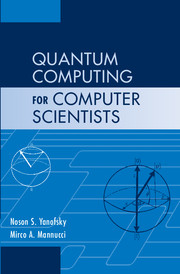Book contents
- Frontmatter
- Contents
- Preface
- Introduction
- 1 Complex Numbers
- 2 Complex Vector Spaces
- 3 The Leap from Classical to Quantum
- 4 Basic Quantum Theory
- 5 Architecture
- 6 Algorithms
- 7 Programming Languages
- 8 Theoretical Computer Science
- 9 Cryptography
- 10 Information Theory
- 11 Hardware
- Appendix A Historical Bibliography of Quantum Computing
- Appendix B Answers to Selected Exercises
- Appendix C Quantum Computing Experiments with MATLAB
- Appendix D Keeping Abreast of Quantum News: Quantum Computing on the Web and in the Literature
- Appendix E Selected Topics for Student Presentations
- Bibliography
- Index
Appendix A - Historical Bibliography of Quantum Computing
Published online by Cambridge University Press: 05 June 2012
- Frontmatter
- Contents
- Preface
- Introduction
- 1 Complex Numbers
- 2 Complex Vector Spaces
- 3 The Leap from Classical to Quantum
- 4 Basic Quantum Theory
- 5 Architecture
- 6 Algorithms
- 7 Programming Languages
- 8 Theoretical Computer Science
- 9 Cryptography
- 10 Information Theory
- 11 Hardware
- Appendix A Historical Bibliography of Quantum Computing
- Appendix B Answers to Selected Exercises
- Appendix C Quantum Computing Experiments with MATLAB
- Appendix D Keeping Abreast of Quantum News: Quantum Computing on the Web and in the Literature
- Appendix E Selected Topics for Student Presentations
- Bibliography
- Index
Summary
This bibliographic essay reviews seminal papers in quantum computing. Although quantum computing is a young science, its researchers have already published thousands of noteworthy articles, far too many to list here. Therefore, this appendix is not a comprehensive chronicle of the emergence and evolution of the field but rather a guided tour of some of the papers that spurred, formalized, and furthered its study.
Quantum computing draws on advanced ideas from computer science, physics, and mathematics, and most major papers were written by researchers conversant in all three fields. Nevertheless, all the articles described in this appendix can be appreciated by computer scientists.
READING SCIENTIFIC ARTICLES
Do not be deterred if an article seems impenetrable. Keep in mind that professors and professionals also struggle to understand these articles, and take comfort in this epigram usually attributed to the great physicist Richard Feynman: “If you think you understand quantum mechanics, you don't understand quantum mechanics.”
Some articles are difficult to understand not only because quantum theory is devilishly elusive but also because scientific writing can be opaque. Fortunately, there are techniques for tackling scientific articles, beginning with these preliminary steps:
▪ Read the title. It may contain clues about the article's purpose or findings.
▪ Read the abstract. It summarizes the article and will help you recognize important points when you read them.
▪ Read the introduction and conclusion. Usually in plain language, the introduction and conclusion will help you decode the rest of the article.
[…]
- Type
- Chapter
- Information
- Quantum Computing for Computer Scientists , pp. 319 - 324Publisher: Cambridge University PressPrint publication year: 2008



